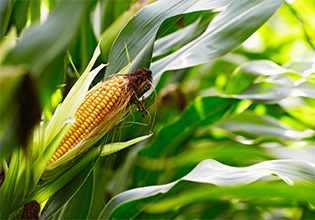Topic in Focus
Fact or Prejudice? Common Statements about Green Genetic Engineering put to the Test

Photo: Adobe Stock / Ingo Bartussek
The majority of German citizens are sceptical about the use of genetic engineering methods in agriculture. This has been confirmed by surveys for many years. The situation is similar in other European countries. At the same time, opinion polls show that the vast majority of people know hardly anything about new methods such as genome editing.
Four out of five Germans reject genetic engineering in agriculture. This is the result of the sixth Nature Awareness Study published in 2019 by the Federal Ministry for the Environment, Nature Conservation and Nuclear Safety and the Federal Agency for Nature Conservation. The representative survey of around 2,000 people aged 18 and over showed that it is “very important” to 44 per cent and “rather important” to a further 37 per cent to ban genetic engineering in agriculture – i.e. both genetic engineering processes and their products. Previous studies had already shown that genetic engineering in agriculture is generally rejected by many people – regardless of the respondents’ educational background and income.
There is also a great deal of scepticism about new genetic engineering methods. Of the approximately 2,000 people surveyed for the Nature Awareness Study, 95 per cent believe that possible effects on nature should always be investigated when plants are “genetically modified using new methods”. Almost 90 per cent doubt that the long-term consequences of “new genetic engineering methods” can currently be foreseen, and only eight respectively 28 per cent trust “completely” or “rather” the statement of scientists that “new genetic engineering methods” are safe.
For years, scientists have been investigating the causes and backgrounds of the widespread scepticism towards genetic engineering in general and green genetic engineering in particular. Studies show that it is frequently not so much a matter of fear or concern about certain risks. Rather, attitudes towards genetic engineering are influenced by a fundamental distrust of technological promises and the economy’s focus on efficiency. The Fourth Genetic Engineering Report of the Berlin-Brandenburg Academy of Sciences and Humanities, published in 2019, refers to the risk perception of green genetic engineering. It states that the reservations towards genetically modified food reflect not only the mistrust of large-scale food production but also the attitude against a technically dominated development of food production and improvement.
Other surveys clearly show that genetic engineering applications are more likely to be accepted if they are aligned with goals perceived as desirable or socially beneficial by the population. The new genome editing methods offer such positively connoted applications. Numerous research and development projects are concerned with breeding stress-resistant or nutritionally more valuable plants without significantly altering the genetic material. Such projects are more likely to be accepted, as shown by the European Parliament’s 2010 Eurobarometer opinion poll on biotechnology. Here, 63 per cent of respondents were in favour of cisgenic apple varieties – i.e. those to which a gene of the same or a closely related species (for instance, a wild apple variety) has been transferred. Half of the respondents saw no danger to the environment in such apples and felt the products were more natural than those of transgenesis, in which genes are transferred between two foreign species.
At the same time, the need for information is obviously considerable. For instance, the 2019 Eurobarometer on food safety showed that only 21 per cent of respondents knew the term “genome editing,” and a close look at common statements about green genetic engineering shows that many claims, while popular, turn out to be undifferentiated, conceptually blurred or simply not accurate.
1. “Genetic manipulation is unnatural.”
Ultimately, this statement can neither be affirmed nor denied because it depends decisively on what one considers to be “nature”. It is often overlooked that the genetic material of plants and all other living beings is constantly changing, even without human intervention. Genetic changes (mutations) occur due to copying errors in duplication, transmission and repair of the genome, or as a result of environmental influences such as solar radiation and oxygen radicals in regular metabolism. However, there have also been human-induced changes in plants since the emergence of agriculture – namely, through selection and cross-breeding.
Genetic engineering makes it possible to transfer genes or gene sequences in the laboratory. If a plant is modified so that it is transgenic, meaning that it contains a gene inserted in the laboratory from an unrelated species, many people are more likely to question its naturalness than if a native or related gene was used, creating a cisgenic plant. The first genetic engineering applications in plants have resulted in transgenic products, for example, maize with a bacterial gene for pest control (Bt maize). A potato variety, on the other hand, to which a gene from a wild potato variety has been transferred in the laboratory is an example of a cisgenic product. Moreover, such transfers are not new. In the conventional breeding process, the transfer of hereditary traits between species-specific or species-related plants has been happening for centuries. Genome editing can bring about processes that can also occur naturally through cellular copying errors of the genome or external influences such as UV radiation from the sun.
“I interpret the term “natural” to be something that occurs or can occur in nature. And if we now look at the simplest form of genome editing, in which, for example, only one letter in the DNA is replaced by another, then we cannot distinguish this change from a naturally occurring mutation. Especially not if we look at the end product and not the process. We also know examples from nature where for instance whole chromosome parts of rye are found in wheat. Some of our best wheat varieties carry these so-called translocations, and therefore, the question is whether the term “natural” has any meaning at all without context.”
2. “Genetically modified plants are a danger to the environment.”
This hypothesis has been investigated in detail by biosafety research over many years. Both the Federal Ministry of Education and Research and the Commission of the European Union found no indications or evidence of specific risks that can be attributed to genetic engineering or correspondingly modified plants. A particularly comprehensive meta-analysis by scientists from the University of Perugia/Italy, published in 2014, also concludes that the scientific investigations carried out to date have not identified any significant hazards in connection with the use of genetically modified crops.
When the consequences of increased pesticide use and adverse effects on biodiversity are mentioned in connection with green genetic engineering, it has nothing to do with the breeding technology itself. Instead, it is due to the type of agriculture practised – i.e. monocultures and intensive use of pesticides. Many projects using the new methods of genome editing, on the other hand, have environmentally friendly goals. The aim is to breed plants that are resistant to pests and diseases without having to use large quantities of chemical agents.
With regard to biodiversity, the following is important to know. Because the use of tools such as genetic scissors is relatively simple and costs little, projects with rare species, only regionally spread species and ancient crop species also become profitable. So the new genomic techniques can even contribute to the preservation of biodiversity.
3. “Green genetic engineering products can cause allergies.”
Fears are often expressed that food from genetically modified plants might be harmful to health and cause allergies. On closer examination, the allergy suspicion proves to be generalised.
Allergies are triggered by proteins. In theory, any protein can trigger an allergic reaction. The risk of this actually happening is given primarily if the protein occurs in higher concentration in the food and if it remains stable in the gastrointestinal tract for a relatively long time, meaning that at least parts of it reach the intestinal mucosa and is able to enter the bloodstream. In addition, the protein in question must contain components that trigger the production of allergy-typical antibodies (immunoglobulins E). This is more likely with certain protein surface areas than with others and cannot be reliably predicted. If such antibodies are present after initial contact, even small amounts of the protein in question can trigger an allergic reaction with each subsequent contact. A well-known example from the realm of food allergies is peanut allergy. Whether a person reacts allergically to a particular protein also depends on the predisposition and a number of contingencies in the characteristics of the individuals immune system.
Plants containing novel proteins can indeed theoretically trigger allergies. The risk increases if they contain proteins whose surface areas are structurally similar to a known allergy-causing protein (allergen). Before approval, transgenic plants – i.e. those containing a foreign gene and consequently, in most cases, a foreign protein – are closely examined for their possible allergenic potential. So far, there has not been a single documented case in which a foreign protein in the plant unexpectedly had an allergenic effect.
“I am not aware of any allergy risk or health hazard arising from the products that have been grown so far. Let me also remind you that in the supermarket nowadays we can buy exotic fruits and other products from plants whose names we have never heard of before. Nobody has ever thought about the allergy risks involved here. In contrast, genetically modified products are very well tested and have undergone a whole series of tests for allergenic potential.”
The regulation to thoroughly test novel foods before they are put on the market is therefore sensible and reduces risks. However, it does not guarantee complete safety because predictions of allergenicity beyond a doubt are only possible to a limited extent. In view of this residual risk, it should be considered that new allergens also find their way into food in other ways. For one, new plant varieties that have been bred conventionally can also contain modified proteins. Secondly, exotic fruits, for example, can also turn out to be new allergy triggers. For some time now, allergic reactions to so-called superfoods such as acerola cherries, dragon fruit and pomegranates have been observed. After establishing kiwis on the menu in this country, allergies to this native fruit variety of New Zealand were also noticed more frequently.
An increased allergy risk exists in principle with all novel foods. With the new genome editing methods, there is at least the possibility of making foods that frequently trigger allergies less allergenic. There are, for example, projects in which allergenic proteins or protein areas of peanut, carrot or tomato plants are to be eliminated or replaced by more tolerable structures.
4. “Green genetic engineering products increase the cancer risk.”
The concern that genetically modified foods increase the risk of developing cancer goes back primarily to a study that made headlines in 2012. The fact that this study was withdrawn a good year later by the journal that had initially published it went largely unnoticed by the general public. French scientists reported in the study that they had discovered in feeding experiments with rats that a specific genetically modified maize, together with the herbicide glyphosate, caused tumours. Among the criticisms following the publication was that the study had serious methodological flaws because, for example, it was based on experimental groups that were far too small for statistically valid statements. In addition, the experiments were carried out on a rat species that is known to be more tumour-prone. Researchers have tried to reproduce the results in numerous elaborate feeding studies lasting up to two years, which the European Union had initiated. No evidence of adverse health effects from the maize variety in question was found.
5. “Genetically modified crops facilitate the spread of antibiotic resistance.”
This concern relates to the conventional genetic engineering methods used since the 1990s. In this process, a gene (usually foreign to the species) is transferred into a plant in the laboratory. Circular DNA elements, such as those found in soil bacteria that naturally infect plant cells, transfer the gene in question. Because this is usually only successful in a handful of the 1,000 cells treated, researchers have to find the cells that have actually been successfully changed. This is made possible through the use of so-called marker genes, which are also transferred. Antibiotic resistance genes were mostly used for this purpose. Plant cells provided with this additional property will grow on antibiotic-containing culture medium and can thus be distinguished in the laboratory from plant cells in which the gene transfer did not work. Such use of antibiotic resistance genes has been much criticised. There have been concerns that resistance will spread to other organisms and ultimately reduce the effectiveness of antibiotics used in human medicine. However, studies show that so-called horizontal gene transfer from plants to bacteria is very unlikely. It has never been proven in nature. Legislation has rendered the concerns obsolete anyway. In the European Union, approval for genetically modified plants containing antibiotic resistance genes has been prohibited since 2008. In the meantime, the technology has been developed further. Gene transfer can also take place without markers, plus, the antibiotic resistance genes can be subsequently removed. The new genome editing methods usually do not use marker genes anymore. Moreover, most of the projects carried out on crops so far do not involve introducing new genes but rather selective changes to the existing genome.
6. “Green genetic engineering serves the profit interests of the agricultural industry.”
Basic research on green genetic engineering is primarily carried out at universities and independent research institutions, which do not pursue any financial interest. Seed companies, however, also invest in research. In order to be able to market green genetic engineering products, they must first go through an approval process, which is relatively strictly regulated, for instance, in the EU. It is not the technology itself but the legal regulation that contributes to the monopolisation of the agricultural industry.The approval processes for genetically modified plants and products usually take a long time and are very expensive. As a result, it is mainly large multinationals that have been involved in the field of green genetic engineering so far. With the new methods of genome editing, which are less cost-intensive, the situation could change. If they were less strictly regulated, as recommended by the scientific community, small and medium-sized enterprises would also have a chance to develop and market genetically modified varieties or their seeds in the future.
“What is actually the meaning of profit-oriented agribusiness? As a society, we have opted for the social market economy model, which is characterised by industrial enterprises that of course make a profit. We don’t get worked up about the car industry making a profit or e-bike manufacturers, for example. But somehow, there is the idea that the agricultural sector should not be profit-oriented. I think that is a problematic argument. I think you have to make sure, as in all other industries, that the market mechanism works for the benefit of all parties involved. If we have too high a concentration in the agricultural industry, then that is problematic. I agree with that. Something has to be done against these increasing concentration processes. But in this respect, genome editing would surely be helpful if we approve such methods without an elevated regulatory burden, so that small and medium-sized breeding farms could also participate.”
Photo: University of Hohenheim / Jan Winkler
This could counteract the process of monopolisation in the already highly concentrated international market. Up to now, this process has been characterised by developments focussing on a small number of plant species – primarily on so-called cash crops such as maize, cotton and soybeans. In the future, genetic scissors could also be used to breed hitherto neglected, insufficiently utilised crops as well as fruit and vegetable plants that are only of regional importance. The spectrum of traits to be improved or supplemented would increase, and less developed countries could also participate in the work.
Published: October 2021


